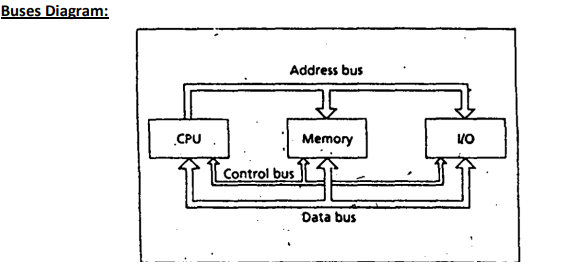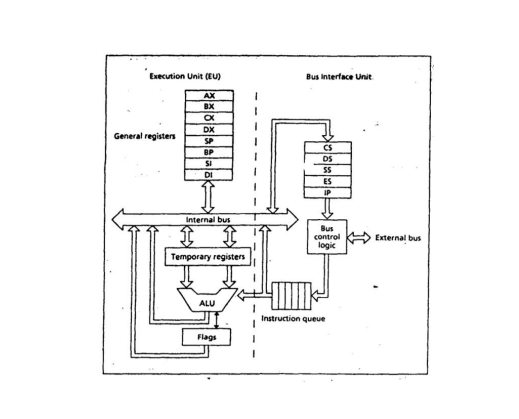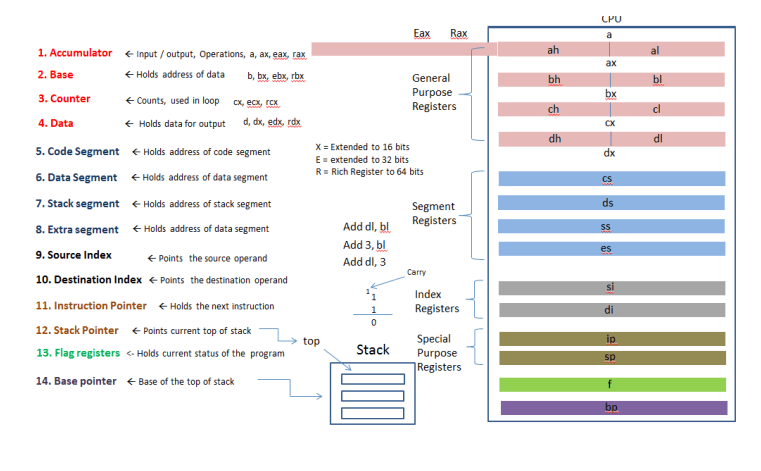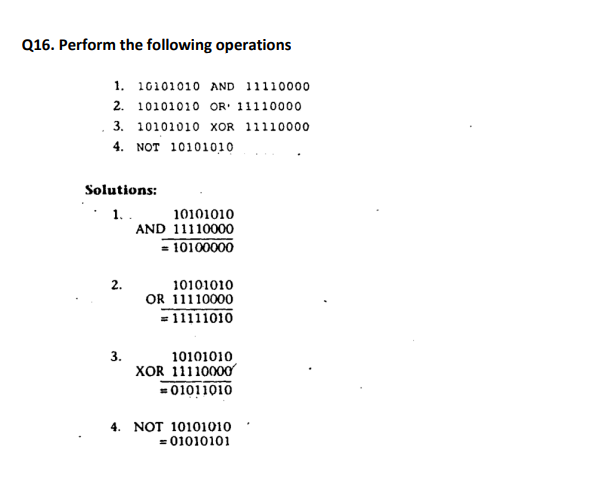Table of Contents- What difference between Machine, assembly, and high-level language?
- Difference between Assembler, Compiler, and Interpreter?
- What are Buses and their types? Also, draw the diagram?
- Difference between the Execution unit and bus interface unit? Draw diagram
- How CPU executes the instruction? What is fetch-execute-cycle?
- Suppose a processor uses 20 bits for an address. How many memory bytes can beaccessed?
- Difference between opcode and mnemonic?
- What difference between a memory location and register?
- Calculate the physical address of A4FB:4872
- What are Registers, describe all registers?
- What is a flag register? Describe all bits?
- What are Assembler directives?
- Describe Data representation in Assembly language programming?
- Draw the Basic Program structure?
- Describe five logic instructions?
- Perform the following operations
- Write some code to multiply the value of AX by 8. Assume that overflow will not occur.
- If CS = 7646H and IP =12BAH, show
- Define the following terms:
- What is STACK? What are stack instructions?
What difference between Machine, assembly, and high-level language?
Machine Language Assembly Language High-level Language It is the native language of
machine It is a low-level computer
programming language which
means it is closer to
machine It is a computer programming
the language that is more close to
human. Consists of 0’s and 1’s Consists of a symbolic
representation (i.e.
Mnemonics) Consists of English like
statements Known as machine code Known as assembly code and
also asm There are many high level
level languages e.g. c, java
and they are called by their
names.
Difference between Assembler, Compiler, and Interpreter?
Assembler Compiler Interpreter Translate assembly code to
machine code Translate the entire high level
language code to machine
code Translate the high-level code
line by line (single instruction
at a time) and then convert to
machine code
What are Buses and their types? Also, draw the diagram?
| Machine Language | Assembly Language | High-level Language |
| It is the native language of machine | It is a low-level computer programming language which means it is closer to machine | It is a computer programming the language that is more close to human. |
| Consists of 0’s and 1’s | Consists of a symbolic representation (i.e. Mnemonics) | Consists of English like statements |
| Known as machine code | Known as assembly code and also asm | There are many high level level languages e.g. c, java and they are called by their names. |
| Assembler | Compiler | Interpreter |
| Translate assembly code to machine code | Translate the entire high level language code to machine code | Translate the high-level code line by line (single instruction at a time) and then convert to machine code |
Buses are the wires that connect the components. (CPU, memory, and input/output
devices).
There are three types of wires:
Address Bus: holds the address of memory location, and address signals.
Control Bus: Inform the memory to perform read operations, and control signals.
Data Bus: Holds the actual data, and data signals.

Difference between the Execution unit and bus interface unit? Draw diagram
The execution unit (EU) executes the instructions, it contains a circuit called the Arithmetic
and logic unit (ALU) and registers. While the Bus Interface Unit (BIU) facilitates communication
between the EU and the memory or I/0 circuits.

How CPU executes the instruction? What is fetch-execute-cycle?
CPU executes the instruction with fetch-execute-cycle as
Fetch:
- Fetch instructions from memory.
- Decode the instruction to determine the operation.
- Fetch data from memory if necessary.
Execute
- Perform the operation on the data.
- Store the result in memory if needed.
Suppose a processor uses 20 bits for an address. How many memory bytes can be
accessed?
A bit can have two possible values, so In a 20-bit address, there can be 220 = 1,048,576 different values, with each value being the potential address of a memory byte. In
computer terminology, the number 220 is called 1 mega. Thus, a 20-bit address can be used to
address 1 megabyte or 1 MB.
Difference between opcode and mnemonic?
Mnemonic is a symbolic representation e.g. AX, BX, ADD, MOV, DB, DW, etc. While
the opcode is a mnemonic that performs the operation e.g. MOV, ADD, SUB, PUSH, etc
What difference between a memory location and register?
Memory locations are locations of external main memory (RAM). While the register is the fastest
location inside the microprocessor (ax, bx, cx, dx, ss, cs, si, di, etc)
Calculate the physical address of A4FB:4872
Step 1:
Multiply A4FB with 10h which is equal to A4FBO
Step 2:
Add
- A4FBOh
- 4872h
- A9822h (20-bit physical address)
What are Registers, describe all registers?
Registers are the fastest memory locations built into microprocessors.
Following are the 14 types of registers

What is a flag register? Describe all bits?
A flag register is a register that contains the current state of the processor. The flag register consists
of status flags and control flags.

Status Flags: To handle the result of an operation.
- Carry: CF (1 if carried out)
- Parity: PF (1 if the number of 1 bit is even)
- Auxiliary: AF (1 if there is 3rd-bit carry)
- Zero: ZF (1 if the result is 0)
- Sign: Flag (1 if the result is negative)
- Overflow flag (1 if result if out of range of destination location)
Controls Flags: To Control the operations of the CPU
- Trap: TF (1 if debugging is used)
- Direction: DF (1 if the reverse function is called)
- Interrupt: IF (1 if the interruption is called)
What are Assembler directives?
Assembly directives are instructions that direct the assembler to do something. They are not converted to machine code. There are different directives in assembly language, some of them are;
- model
- stack
- data
- code
- Db, dw, dt
Describe Data representation in Assembly language programming?
In assembly, data can be represented in the following ways
| 11011 | Decimal |
| 11011B | BINARY |
| 64223 | DECIMAL |
| 21843D | DECIMAL |
| OFFFFH | Hexadecimal number |
Draw the Basic Program structure?
;Title of the program Dosseg .model small .stack 100h .data ; variables are defined here .code Main proc ; procedure start ; executable instructions Main endp ; procedure end End main
Realted : Network Security Punjab University Solved Past Paper 2020
Describe five logic instructions?
The five logic instructions are AND, OR, NOT, XOR, and TEST.
- The AND Instruction can be used to clear individual bits in the destination.
- The OR instruction Is useful In setting individual bits in the destination. It can also be used to test the destination for zero.
- The XOR instruction can be used to complement individual bits in the destination. It can also be used to zero out the destination.
- The NOT Instruction performs the one’s complement operation on the destination.
- The TEST Instruction can be used to examine individual bits of the destination. For example, It can determine If the destination contains an even or odd number
Perform the following operations

Write some code to multiply the value of AX by 8. Assume that overflow will not occur.

If CS = 7646H and IP =12BAH, show
- The Logical Address
- The offset Address
- Physical Address
Solution:
Segment Address = CS = 7646H
Offset Address = IP = 12BAH
Logical Address= Segment: Offset
= 7646H : 12BAH
Physical Address:
First Multiply 7646H with 10h = 76460H
Now add 76460H and 12BAH = 7771Ah
So, physical address is 7771AhDefine the following terms:
- SAL and SHL
- SHR
- SAR
- ROL
- RCL and RCR
SAL AND SHL
SAL and SHL shift each destination bit “left one place. The most significant bit goes into CF,
and a 0 Is shifted Into the least significant bit.
SHR
SHR shifts each destination bit right in one place. The least significant bit goes into CF, and a 0
ls shifted into the most significant bit.
SAR
SAR operates like SHR, except that the value of the most significant bit is preserved.
ROL
ROL shifts each destination bit left one position; the most significant bit is rotated Into the least significant bit.
RCL and RCR
RCL and RCR operate like ROL and ROR, except that a bit rotated out goes Into CF, and the value of CF rotates into the destination.
What is STACK? What are stack instructions?
Stack
The stack is a temporary storage area that works on LIFO (last-in, first-out data) principle.
Stack instructions
The stack-altering instructions are PUSH, PUSHF, POP, and POPF.
PUSH: adds a new top word to the stack
POP: removes the top word.
PUSHF: saves the FLAGS register on the stack
POPF: puts the stack top into the FLAGS register.
SP decreases by 2 when PUSH or PUSHF is executed, and It increases by 2 when POP or
POPF is executed
Related: No Parameterless Constructor Defined for this Object